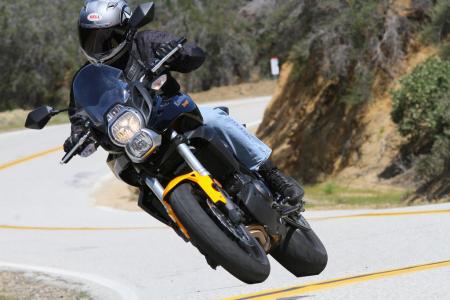2012 Kawasaki Versys Review - Motorcycle.com
When Suzuki alluded to the Kawasaki Versys as a competitive benchmark for the born-again V-Strom 650, we took note. Not having ridden the Versys since its 2010 makeover, we ordered one up in advance of a comparison test.
Since last reviewing the Versys, its cost has grown $300 from an MSRP of $7,600 in 2010 to $7,900 for 2012. What three more Bens buys you is a new color (a striking Pearl Solar Yellow/Ebony combo) and a bunch of inflation. The 2010 Versys’ $500 price bump boasted a host of upgrades including:
* A new fairing, stacked dual headlight, new front fender and mirrors, and an LED tail light
* A larger windscreen with three-position adjustability
* Revised passenger grab rails, new seat cover material, and revised passenger seating position
* Rubber bushings at the rear engine mounts and hollow rubber-covered footpegs
* Revisions to the muffler, clutch cover, sprocket and alternator covers, radiator shrouds, swingarm pivot covers and rear fender
The Versys, with its longish (5.9 in. front and 5.7 in. rear) suspension travel and tall 33.3-in. seat height, conveys a certain degree of off-road capability, but its 17-inch cast aluminum wheels and Dunlop Sportmax tires speak to its true nature. Sure, a person can modify the Versys to be more capable of off-road work, but more suitable bikes exist. Our forthcoming shootout will examine the relative merits of each manufacturer’s approach to achieving a useful street/dirt balance.
As an urban-assault cycle, the Versys excels. Its snappy, 649cc parallel-Twin engine jettisons away from stoplights and makes short work of navigating heavy city traffic. The large passenger grab handle doubles as an effective appendage for securing items when in-transit, while the Versys’ mirrors provide an unobstructed view of dangers approaching from behind.
Beyond city limits the Versys is a great weapon for attacking gnarled switchbacks and embarrassing sportbike pilots tiptoeing across chunked asphalt. Or, attach Kawasaki’s available hardbags and head out for a tour of the contiguous 48. The Versys’ neutral seating position provides a balanced combination of comfort and control, and its three-way adjustable windscreen deflects more or less wind depending on the situation.
The result of trying to keep a fairly low seat height is a short distance from footpegs to seat that cramps taller riders and is exacerbated by a concave section at the rear of the seat where tall riders sit. Our shorter testers weren’t bothered, but tall riders are faced with increasing discomfort as the miles accumulate — those above six feet might want to look at aftermarket alternatives.
Kawasaki endowed the Versys with rebound and preload damping adjustability to both the 41mm inverted front fork and lay-down rear shock. The instrument cluster, while spartan, includes a fuel gauge, clock and dual tripmeters. Adjustable clutch and front brake levers ably fit a variety of hands.
At approximately 490 lbs with its 5.0-gallon tank full, the Versys is kind of hefty for a mid-displacement Twin producing 56.5 hp at 8250 rpm, but its linear powerband is a willing accomplice in most any situation short of long, open roads or a racetrack. Fuel mileage in our hands was in the low-to-mid 40-mpg margin, so the Versys has an admirable range of more than 200 miles. Its 6-speed transmission was less impressive, exhibiting a clunky response to our toes.
Consensus in our 2010 review of the Versys was “if faced with a budget for only one mid-size street bike, a lot of riders – old, young or in between – might want to take a closer look at the Versys.”
What we’ll soon discover is how the Versys stacks up against two equivalent, yet more dirt-worthy adversaries. At $8,300 — including ABS — the Suzuki V-Strom is marginally more expensive than the Versys, but is the 645cc, V-Twin-powered Strom a better all-around bike? Same goes for the $7,850 BMW G650GS, which also incorporates ABS but is powered by a relatively meek 652cc Single.
Related Reading
2010 Kawasaki Versys Review
2012 Suzuki V-Strom 650 ABS Review: First Ride [Video]
2012 BMW G650GS Sertao Review
2011 BMW G650GS Review [Video]
2011 Adventure-Touring Shootout: Triumph Tiger 800XC vs. BMW F800GS [Video]
2011 Triumph Tiger 800 & 800XC Review [Video]
More by Tom Roderick

































Comments
Join the conversation